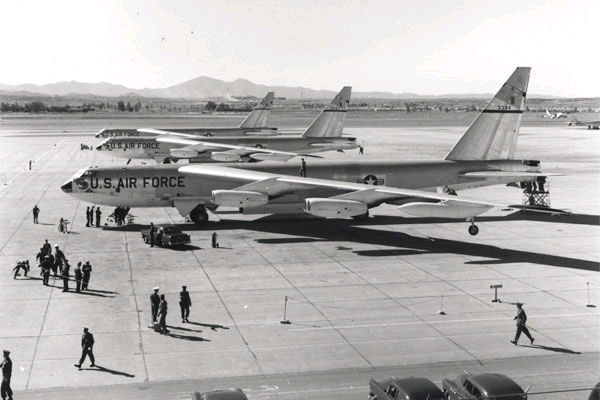America’s legendary B-52 Stratofortress first took to the skies more than 70 years ago and will likely remain in service beyond its century mark. In fact, the B-52 is now slated to continue flying long after much newer bombers, the B-1B Lancer and B-2 Spirit respectively, have already been sent out to pasture.
But what may be most incredible about this long-lasting and broadly capable platform is that the aircraft itself, often referred to as the BUFF (Big Ugly Fat Fellow), was actually designed over the span of a single weekend by a small group of Boeing engineers stuffed into one hotel room in Dayton, Ohio.

B-52Bs on the flightline in 1957 (U.S. Air Force photo)
The B-52 started flying when America was still relying on P-51 Mustangs
The B-52’s prolific service career spans not only decades and conflicts, but eras of aviation. The aircraft was born at a time when the very concept of combat aviation was being reborn into the jet age.
When the B-52 first took flight in 1952, the F-51 Mustang — an updated iteration of the World War II P-51 — was still among the primary fighter-bombers in service over the Korean War. By the time the mighty BUFF entered service in 1955, however, the supersonic jet-powered F-100 Super Sabre was already in operation.
But in this era of rapid change, the B-52’s swept-wing design and jet propulsion quickly proved the platform was not only capable of keeping pace with the times, it quickly began raising the bar for what was considered feasible for a bomber platform.
One year after entering service, a B-52 conducted the world’s first air-drop of a thermo-nuclear weapon over the Bikini Atoll, proving the aircraft was a bonified nuclear powerhouse. The following year, it proved it had global reach when three B-52s conducted a non-stop round-the-world flight in just 45 hours and 19 minutes, thanks to in-flight refueling. The next year, in 1958, multiple B-52s would set world-speed records. Soon, a number of other records would fall to B-52 crews, including multiple new records for distances flown without refueling.
After Gary Powers’ U-2 was shot down in 1960, the B-52’s preferred approach to bombing from 50,000 feet no longer seemed feasible. Rather than retire their new bomber, however, the Air Force quickly assessed that the aircraft’s flexible design could transition into a low-flying bomber deploying munitions from as low as just 400 feet or lower, below where radar could track.